Stirling, Bennett, Schendler: Let’s create the greenest airport in America, Aspen Times
Posted from Aspen Times Opinion: September 5, 2024
Considering our airport, let’s pretend you cared only about the environment — and particularly climate change. You support the ambitious community goal of reducing airport greenhouse-gas emissions by 30%. How would we get there? As three, longtime valley residents who have worked on climate change for decades, we’ll try to answer this.
Our first data point: Aircraft account for more than 92% of airport emissions. That means the type of aircraft flying into Aspen matters more than anything else. Project Drawdown, a think tank studying science-based climate strategies across economic sectors, analyzed aviation and greenhouse-gas emissions. They conclude that the best way to reduce aircraft emissions is “the adoption of the latest and most fuel-efficient aircraft; retrofitting existing aircraft with winglets, newer engines, and lighter interiors; and retiring older aircraft early.”
Aspen’s existing airliner, the CRJ-700, is dirty-burning and noisy. (Ask any airport neighbor.) Its planned replacement, the Embraer E175, has higher emissions and is even noisier. To cut airport emissions, we need the next generation of aircraft that are cleaner and quieter.
Future airliners now being developed by Airbus and Boeing have one thing in common: wider wingspans for fuel efficiency and emissions reduction. As Sue Partridge, director of the Airbus Wing Technology Development Centre, explained recently, “The physics show us that in order to get a more efficient wing, it needs to be longer and more slender.”
The Airbus A220-100 is an example of a cleaner, quieter plane. Delta flies it today with 109 seats (only slightly more than past Aspen airliners). Purpose-built for efficiency and low noise, the A220-100 emits less than half the carbon pollution per passenger mile of the CRJ-700.
The citizens of the Airport Vision 2020 Committee suggested the A220-100 as the ideal plane to serve Aspen, but we can’t use it because its wingspan exceeds 95 feet. Yet this is the sort of technology we should be promoting: better service with half the energy. Keeping today’s noisy, polluting airport would mean this jet could never fly here. Conversely, a modernized airport opens the doors to cleaner, quieter planes of the future.
(As an aside, while changing fuels to “sustainable aviation fuel” can reduce emissions if done right, it isn’t a given — it’s hard to produce at scale, and it will become obsolete when future airliners are electric or hydrogen-powered.)
Our second data point: Fewer than 5% of arriving airport travelers use mass transit. A new airport terminal could seamlessly integrate transit into the terminal itself, dramatically increasing usage. We could emulate the car-free quality of many European resorts, where airline passengers ride transit directly to hotels with luggage delivered straight to their room. And the relatively short round trips between the airport and downtown Aspen and Snowmass (versus 90-mile Aspen–Glenwood Springs round trips) mean that the airport bus routes could be among the first to go 100% electric.
The third data point: Our terminal is not just a terminal. It’s a tool for reaching the hearts and minds of hundreds of thousands of influential people each year. With FAA support, we could build an all-electric, net-zero terminal that is the envy of the world. It could incorporate educational tools into the building itself — think video and wall displays, public energy monitoring, “truth walls” that reveal building construction. Role modeling is what Aspen was meant for; we could inspire others and help change the world.
The fourth data point: Replacing connecting flights with direct flights radically cuts emissions (Project Drawdown). This means replacing long DIA waits and Denver-Aspen legs with more directs from, say, Los Angeles, Boston, or New York. The A220-100 could do this. And allowing direct flights from Boston would not result in more flights or people coming to Aspen. Enplanement growth would still be managed by the new terminal’s 6-8 “flexible gates.” Direct flights will simply remove a carbon-intensive takeoff from a current two-leg flight. That’s a win-win for both weary travelers and those worried about climate change.
We’ve spent much of our lives working on climate change. Aviation emissions is one of the trickier areas to solve. But our best bet is not to downgrade our airport and condemn it to jets of the past but to follow the best climate research and modernize the runway to allow the cleaner, quieter jets of the future, while simultaneously building a model airport that can inspire the world.
This was written on behalf of Bill Stirling, Aspen mayor 1983-1991, and environmentalist since the mid-1980s; John Bennett, Aspen mayor 1991-1999, environmentalist, nonprofit director; and Auden Schendler, senior vice president of Sustainability, Aspen One.
